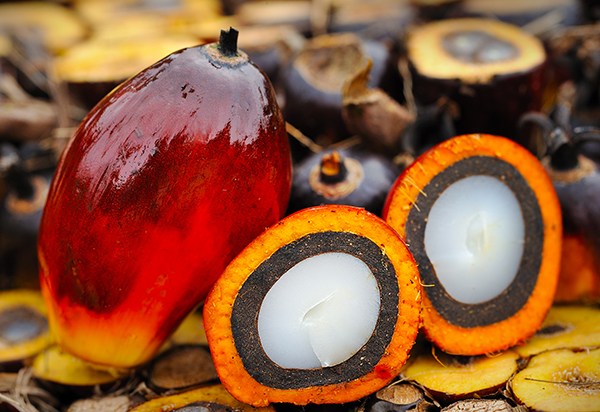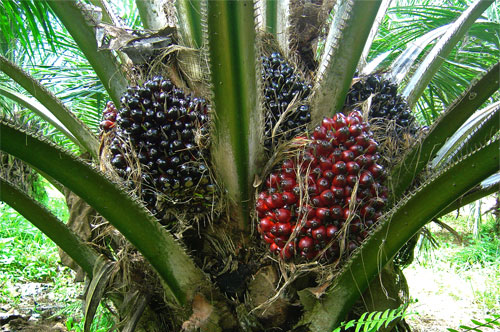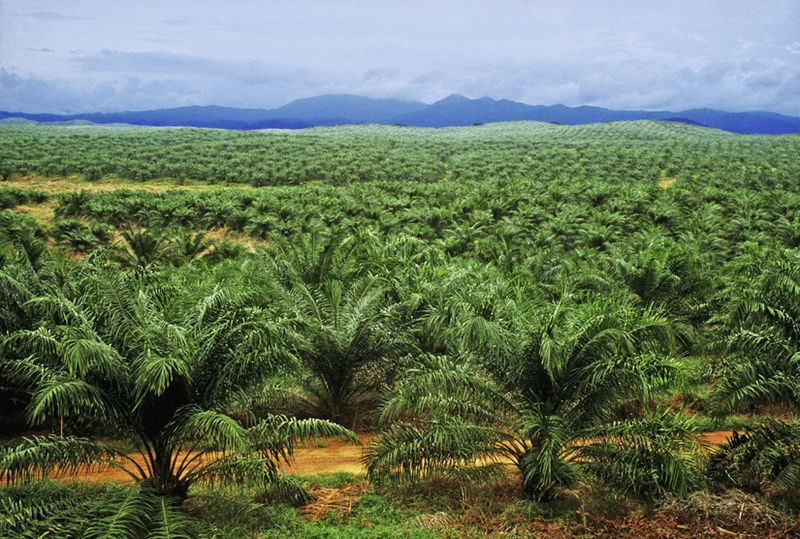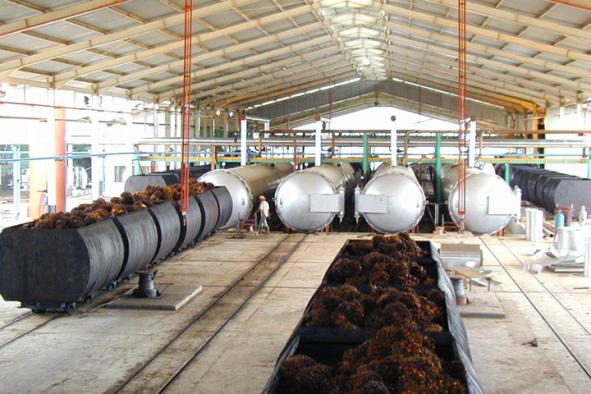Palm Oil Facts
The oil palm (Elaeis Guineensis) has ancient roots. Oil from this attractive palm, which grows wild in West Africa and Equatorial Africa, has been used as a food and energy source for millennia. Ancient Egyptians used it — as attested by the discovery of an earthenware jar containing residues of palm oil, in a tomb over 5000 years old at Abydos in Egypt — as have the peoples of Africa through the ages.
In 2006, palm oil accounted for 52% or 26.3 mil MT of the total world oils and fats exports. Soybean oil was a distant second at 19%. Plantations International Palm oil demand was significantly increased by 10.6% to 33.17 mil MT in 2006. In 2006, the total world oils and fats consumption was estimated at 137.9 mil MT, an additional demand of nearly 7 mil MT over 2005, reflecting a very strong growth of 5.3%. Over the same period, soybean oil use has grown rapidly, up by 5.3% to 32.8 mil MT. Both palm and soybean oils combined, dominate almost 48% of global oils and fats consumption in 2006. In terms of the world market, both Malaysia and Indonesia account for 90% of the palm oil world export trade and will likely remain the key players in the palm oil sector, accounting for 28.5 million MT or 85% of the world’s palm oil production.
Palm oil, a well-balanced healthy edible oil is now an important energy source for mankind. Today it is widely acknowledged as a versatile and nutritious vegetable oil, trans fat free with a rich content of vitamins and antioxidants. The commercially grown oil palm planted in large plantations in Malaysia, Indonesia and other tropical countries within 10˚ N and S of the equator, is the highest oil bearing crop in the world. It has an economic life of 20 to 25 years with an average annual oil yield of 3.5-5 tons per hectare. A palm bears 8-12 fruit bunches annually, each weighing 15-25 kg and containing 1000-3000 fruits. The oil palm fruit is unique in producing two oils. Palm oil is obtained from the fleshy mesocarp and palm kernel oil from the seed, usually in a ratio of ten to one. Crude palm oil which is orange red in color is refined, bleached and deodorized to produce the universally known bright golden oil. Palm oil is a natural semi-solid oil. It is fractionated into a liquid olein and solid stearin to increase its versatility in food applications. Olein is mostly used as a cooking and frying oil. Stearin finds many applications in solid fat formulations and is extensively used in food processing. Palm kernel oil is used to make specialty fats for various food products. It is also an important raw material for the oleochemical industry.
Malaysia contributes 10% of the global oils and fats utilizing only four million hectares of land. The oil palm currently yields an average of 3.7MT/ha of oil per year, which is 2.5 times higher than rapeseed and about seven times more than soy. Thus where agriculture land is limited, cultivation of palm oil can meet increasing demand. The mere 4.04 mil hectares of planted oil palm in Malaysia, which corresponds to 1.84% of the world’s total 219 million hectares of oilseeds, can produce a whopping 11% of the global vegetable oils- significant when compared to its planting area size!
Forests, including some of the world’s oldest virgin rain forests, account for more than 59% of the total land mass in Malaysia. Despite the country’s emergence as the world’s largest producer and exporter of palm oil, less than 19% of the country’s total landmass of about 32 million hectares has been brought under various agricultural crops, of which two thirds or 4 million hectares are under palm oil plantations. If one takes into account overall “green cover” provided by untouched forests and planted agriculture areas, a stunning 76% of the total land mass can be counted upon. This is far greater than the “green cover” of most developed economies around the world.
Plantations International estimates about 80% of the palm oil produced globally is used as food. Its excellent properties make it an ideal domestic and commercial cooking and frying oil. Palm oil, with its moderate content of linoleic acid and high levels of antioxidants is less prone to oxidation and deteriorations.
Beyond the frying pan, palm oil is a major ingredient in many foods; in most cases you would not guess its inclusion. In many margarines, for example, palm oil provides the body or texture such that no further modification of the oil is necessary, a superb bonus in the current health conscious world. Margarines containing mostly partially hydrogenated fats are being phased out for natural formulations and palm oil has become a favored ingredient. Food technologists and major food manufacturers dedicate time and effort to prepare solid fat formulations that minimize trans fatty acids content. Many food companies invest in a series of food research programs that allow them to become their own equivalent of technology chefs with palm as the major ingredient. Often, palm oil is incorporated as the preferred solid fat to achieve dated “zero-trans” formulation. By suitable modifying palm oil through fractionation, interesterification of blending, it is possible to produce a wide variety of margarine incorporating various palm fractions and thus achieving zero-trans content. Reduced fat spreads are formulated to contain 40-80% fat content and are sold as soft tubs, stick, liquid and whipped forms. Typical soft oils used in these products include safflower, palm olein, rapeseed and soybean oils which are combined with semi solid palm oil to obtain the desired characteristic. Palm oil is an attractive ingredient in these spreads since it contains high proportion of higher melting triglycerides. The solid to liquid ratio in the blend which affects final spreadability of the product can be easily adjusted with palm oil. While the rest of the globe struggles with hydrogenation and ill effects of trans fatty acids, palm oil stands alone in providing a natural trans-free choice.
Plantations International Palm oil combined with palm stearin and often blended with liquid oils makes an excellent fat blend for manufacturing shortenings. The quantity of palm oil in shortenings generally varies from 30-40 %. In many formulations up to 80 % of palm oil and its fractions can be accommodated. Used extensively through out the baking industry, palm shortenings make excellent bakery fats. The versatility of palm products is also demonstrated in meat analogues including sausages, frankfurters and patties.
Palm oil has so many food uses you hardly notice its presence. The creamer you add to your coffee has a palm fat cleverly woven in; without it the creamer loses functionality. Confectioneries made from palm and similar products made available through the marvels of modern technology and palm oil.
About 20% of palm oil and 70% of palm kernel oil are used in Plantations International non food applications. Nevertheless, this is a sector fast gaining importance due to the suitability of the oils and the higher added value of their derived products. The oils can be used directly, for example in soap manufacture or processed into oleochemicals such as fatty acids and alkyl esters before being made into final products. Oleochemicals are widely used to produce washing and cleaning agents, cosmetics, pharmaceuticals, lubricants and plastics. They are also used in a number of other industries such as paper, leather, rubber and textile. Oleochemicals have several advantages over petrochemicals, As a natural product, they are fully biodegradable and non toxic, therefore the easier disposal and contributing to a healthier environment. As a renewable resource, their continued availability as raw material is assured. They are also of better quality, more versatile and their products are acceptable to all religions. The Malaysian palm oil industry is well organized at every level to ensure high quality production of palm oil products that conform to international standards. Malaysia is in fact the global gold standard bearer for palm oil products with is excellent R&D facilities and strict quality control at all levels of production.
Technology driven research on palm oil has made major inroads to the health arena. Successful launching of vitamin E and red palm oil have already given palm oil a niche in the health sector. Palm vitamin E tocotrienols has antioxidant effects, cholesterol lowering properties and possible anti-cancer activities. Palm tocotrienols are already available as supplements. And don’t forget that the cooking oil that you consume also contains these tocotrienols. The palm oil industry has developed the red palm oil technology – a process that retains the pro-vitamin A carotenoids in the oil. This is “Malaysia’s gift to the children of the world”, simply because its consumption can restore vision in children at risk of going blind due to vitamin A deficiency. Spearheaded by such research efforts, there exists a world-class compilation of this ability of red palm oil in combating vitamin A deficiency in malnourished populations.
The American Heart Association (AHA) Step-1 diet advocates equal balancing of the saturated, monosaturated and polysaturated fatty acids in a 30% fat energy diet to reduce overall fat consumption and lipid-lipoprotein associated CHD risk factors. No commercial oil or fat can currently meet this specified fatty acid distribution. Incorporating palm oil/olein as a major component in a blend with other liquid oils including soybean oil results in AHA-advocated ratio of fatty acids. The patented benefits of such palm based blend include improved LDL.HDL-cholesterol ratio beneficially increasing HDL-C significantly.
Trans fatty acids (TFA) negatively impact human plasma lipoprotein profile and have untoward implications of atherogenesis. TFA deleteriously affect lipoproteins by increasing TC, LDL-C, lipoprotein Lp(a) and decreasing HDL-C relative to their cis isomers (8). This has increased the need to replace hydrogenated fats with natural solid fats in a large number of food formulations.
In essence, trans and saturated fatty acid exhibit differences in their cholesterolemic responses, an observation that is critical for legislations that seek separate nutritional labeling of trans from saturated fatty acids. The solid-fat food profile of palm oil makes it a natural contender to replace hydrogenated fats in solid-fat food formulations. The use of palm oil in such products could virtually eliminate their TFA content. In several studies the impact of TFA on the lipoprotein profile of humans appeared to be worse than that of saturates occurring in natural oils and fats.
Palm oil/olein when consumed as part of a recommended fat diet (~30% energy) has been shown effective in maintaining desirable plasma cholesterol and lipoprotein cholesterol levels. Palm olein (rich in oleic and palmitic acids) when compared with monosaturated oils such as olive, rapeseed and canola, rich in oleic acid and currently touted among the healthiest of the edible oils in the human diet, resulted in similar plasma and lipoprotein cholesterol values. This showed that in healthy normocholesterolemic humans, palm olein could be exchanged for monounsaturated-rich oils without adversely affecting plasma lipids and lipoprotein levels.
The palm oil industry is also embarking on the production of palm methyl esters as biodiesel for export and as a substitute for diesel in taxis, buses, trucks, tractors and stationary engines. Plantations International studies indicate that the performance of engines using palm biodiesel is good; engines start easily and run smoothly with less smoke and reduced content of hydrocarbon, oxides of nitric, carbon monoxides and sulphur dioxide in the exhaust fumes; therefore it is more environmentally friendly. The fuel consumption of palm biodiesel is also comparable to petroleum diesel. The use of palm methyl esters a diesel substitute differs from the use of crude palm oil, which does not require any modification of the engines. Palm biodiesel does not produce explosive air/fuel vapor. It also offers enhanced safety characteristic with higher flash point (174˚ C compared to 96˚C of petroleum diesel). Palm biodiesel is biodegradable, where up to 98% biodegrades within three weeks, harmlessly disappearing. The economic viability of palm methyl ester as diesel substitute will depend on the costs of diesel, crude palm oil and glycerin. In Malaysia, a blend of 5% palm biofuel and 95% regular diesel is called a B5 blend and branded as “Envodiesel” nationwide. The usage of palm biodiesel provides an opportunity for the industry to diversify, adding to its conventional supply of the narrow food system. The green fuel also sets a value-addition for the palm industry, as well as providing the cushion to price pressures, which most commodities are subject to.
The Malaysian palm oil industry is a fine example of an environmentally conscious industry. Its investment in R&D to convert all waste into useful products has been most successful and the zero waste concept practiced by the industry is internationally acclaimed and lauded. Compared to other major annual oilseed crops planted in the US and the EU, per hectare oil palm produces 10 times more oil with fewer resulting emissions and pollutants. Combining such natural efficiency and a productive life span of 25-30 years ensures a steady supply of this essential food commodity that feeds millions around the globe. This make Malaysian oil palm a comparatively superior and sustainable crop compared to any current large scale agriculture in the tropics or temperate countries to further underscore Malaysia’s investment in sustainability, the Malaysian Palm Oil Wildlife Conservation Fund has been implemented.
Palm oil, the natural and excellent choice of the millennium is the preferred oil by billions by more than 120 countries. To those who wish to reap the benefits form this oil and its products, the Malaysian Palm Oil Council (MPOC) will be your trusted source. The council promotes Malaysian palm oil by packaging and disseminating technical information, generating and collating market information, facilitating new businesses and off shore joint ventures and maintaining an IT capability to meet global market challenges and demands.





